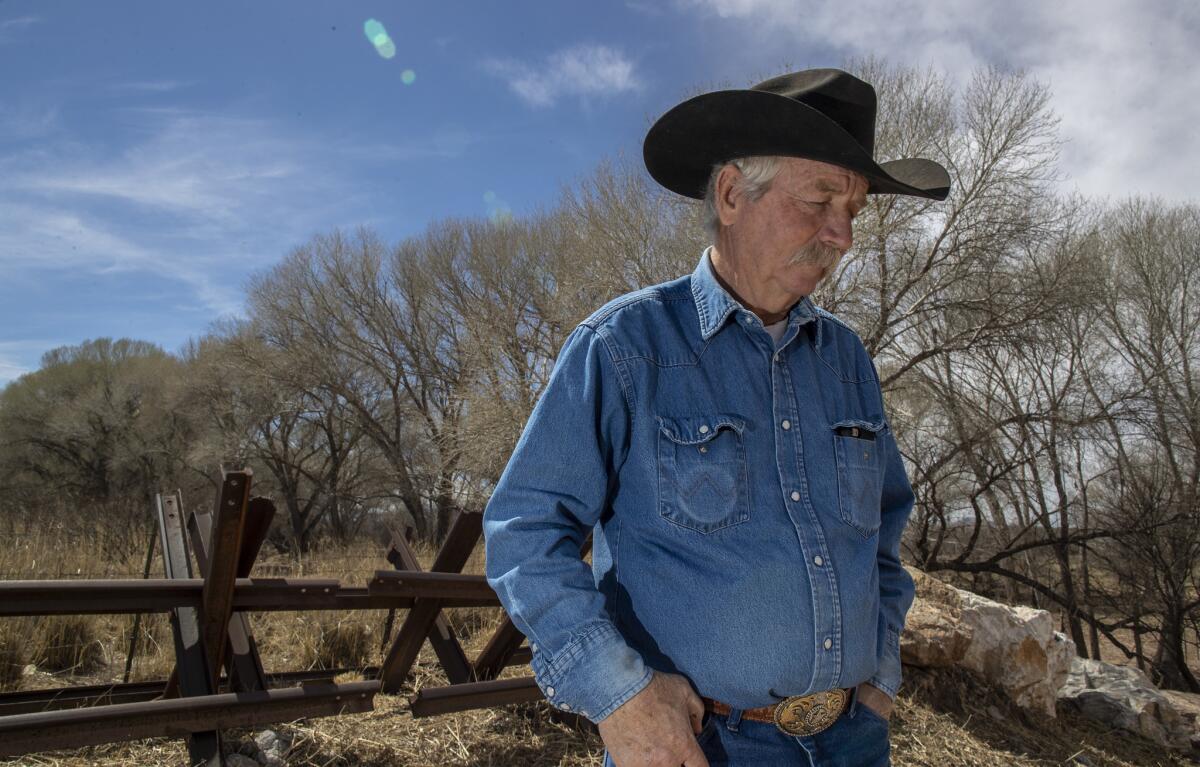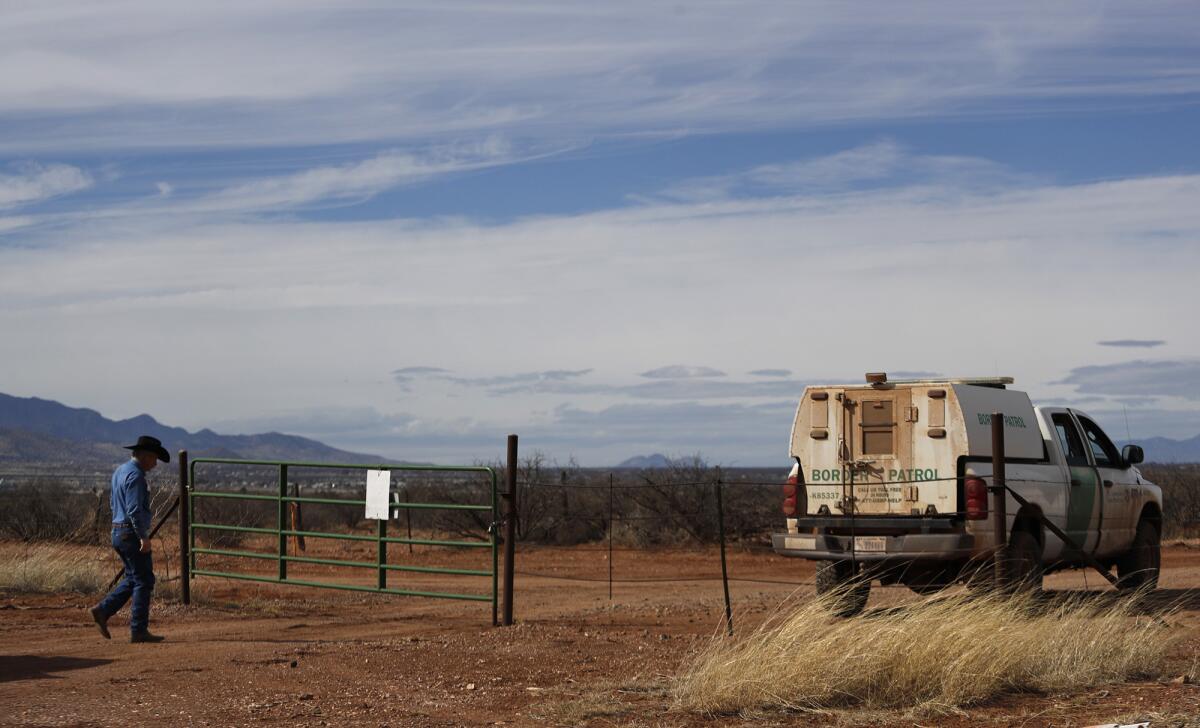Must Reads: Arizona ranchers who supported Trump wall now have doubts about border plans

- Share via
Reporting from Naco, Ariz. — When Donald Trump was elected president, rancher John Ladd said smuggling traffic on his ranch immediately dipped, and he slept soundly for the first time in years.
Ladd, 63, a fourth-generation cattle rancher, had voted for Trump and his promise to build a border wall and have Mexico pay for it. But the wall hasn’t been constructed, the respite didn’t last, and Ladd, along with other vocal southern Arizona ranchers, has lost faith in the Border Patrol’s barrier plans.
“If they build a wall and do what they did to us, it isn’t going to work,” Ladd said last week as he drove through the 10½-mile stretch of his ranchland that borders Mexico — roughly from the community of Naco west to the San Pedro River.
All but about half a mile of the border on his ranch is already fenced, a patchwork of varying heights, all erected on his land prior to the Trump administration. To his immediate west, at the foot of the Huachuca Mountains, the fence ends.
The first stretch of new fence planned for construction by the Trump administration is not slated for the Arizona desert but for Texas and is mired in environmental and land disputes. Even if that project moves forward and is expanded to Arizona, Ladd and some other ranchers now doubt it will stop smugglers unless the Border Patrol changes its policies and deploys agents closer to the new barriers.

Arizona rancher Jim Chilton has been calling for more border security, including a wall, for many years. Traffickers use his land to transport drugs, he says, and immigrants have died crossing his ranch, in what he calls “a horrible, horrible human
Ladd’s friend and fellow rancher Jim Chilton still believes in Trump’s wall, but describes the project as three-pronged.
“You need a wall. You need roads. And just as important, you need the Border Patrol at the border,” said Chilton, 79, whose cattle ranch on the border a dozen miles west of Nogales is fenced with only barbed wire and frequented by smugglers, he says.
Chilton was invited to meet the president at the American Farm Bureau Federation convention in New Orleans in January, where Trump acknowledged smuggling traffic on Chilton’s ranch and brought him up to speak.
“Mr. President,” Chilton said after taking the stage in his Stetson and bolo tie, “we need a wall.”
Chilton didn’t mention the need for Border Patrol agents to monitor traffic along the barrier. He figures once the wall is built, “then we put pressure on the Border Patrol to change their strategy.”
But other ranchers who voted for Trump say his “big, beautiful” wall won’t work without first improving how the Border Patrol monitors existing barriers. They say a trip along Ladd’s property illustrates their concerns.
Fred Davis, 67, a fourth-generation rancher east of Tombstone, about 30 miles from the border, calls the barriers erected on Ladd’s 16,500-acre ranch “the greatest technological boondoggle on the border” and says they show that “it doesn’t matter what you put on the border if you don’t have boots on the ground to monitor it.”
Ladd’s friend Gary Thrasher, a rancher and veterinarian, voted for Trump and supported the wall, but has doubts after what’s happened at Ladd’s ranch.
“It’s sickening to me that that much has been invested in something not well thought out,” said Thrasher, 73.
He pointed to one stretch of fence, a black ribbon winding up a hill and ending at the San Pedro River.
The Border Patrol has spent about $54 million on fencing, cameras, towers, radar and other technology on Ladd’s ranch since 1992, he said. Most of the construction started after the Secure Fence Act of 2006 was passed, and ended in 2017 before Trump took office.
But it’s by no means secure, he and his friends say.
The money “would have been better spent on manpower,” said Ladd, a mustachioed cowboy who chewed tobacco as he drove in his pickup beside a stretch of fence built in 2009.
The fence here is a patchwork of 18-foot-tall steel bollards, 13- and 10-foot mesh fence, waist-high X-shaped Normandy vehicle barriers, and floodgates that sit open during summer monsoons. Ladd says the barriers slow smugglers but don’t stop them, especially in gaps under the fence called draws where cameras can’t spot them.
“They should have an agent here,” he said last week as he stopped near Gringo Draw.
No agents were in sight.

The Border Patrol has stationed an agent near the ranch’s eastern entrance beside the Naco crossing, and another to the west at the San Pedro River. But they keep watch by “sitting on Xs,” as Ladd put it, instead of surveying gaps in the fence.
At one point, a third agent passed slowly in an SUV, on patrol.
“That’s one,” Ladd said wryly.
Most of the fencing on Ladd’s property was built during the Obama administration. Trump sent active-duty U.S. troops to the border, and worked with governors to send National Guard troops, but the guardsmen he’s seen are not armed like they were under President Obama.
The irony is not lost on Ladd.
He has made his views known to the Naco Border Patrol station advisory committee he serves on, testified in Washington, hosted members of Congress and 2016 presidential candidates including Ben Carson and Rick Perry. He also attended a border security meeting about 190 miles to the northeast in Deming, N.M., on Saturday where Ladd said Thrasher and other Arizona ranchers addressed a crowd of more than 400 people upset with Border Patrol strategy in rural areas that in recent months have seen an influx of migrant family groups.
Ladd and other ranchers feel ignored.

Instead of Trump changing the strategy of the Border Patrol, he sees the president taking his cues from agency managers and the agents union.
The Border Patrol has relied over the years on shifting agents to high-traffic areas, often around border cities. Critics say that leads to a “water balloon” effect, driving smugglers and migrants to ranches patrolled by fewer agents.
Agent Dan Hernandez, a spokesman for the Border Patrol’s Tucson sector, is aware of complaints from Ladd and other ranchers.
“He wants agents holding hands” along the border, Hernandez said.
And while that might improve security in densely populated urban areas, Hernandez said, it wouldn’t help in places like Cochise County, with a population of about 125,000 spread across an area larger than Los Angeles and Orange counties combined, including Naco.
In Texas’ Rio Grande Valley, agents patrolling fenced stretches of the border have backup patrols stationed along highways farther north and at checkpoints on every major highway. Arizona’s Cochise County is assigned fewer agents and checkpoints, which often are closed due to storms.

“Once you beat us” in rural southern Arizona, Hernandez said, “you’re home free.”
As smuggling traffic shifted during the last 20 years away from Arizona toward Texas, so did agents. Frustrated, Ladd partnered with the local sheriff’s office two years ago.
The sheriff, who serves on a national Homeland Security advisory committee, used state and federal grants to send a team of five deputies to Ladd’s ranch, where they installed 50 camouflaged game cameras usually used to track wildlife at a cost of $1,000 each. Authorities tracked and charged 50 drug traffickers, all of whom were prosecuted. For the past 13 months, no drug activity has been seen in the area as a total of 500 cameras have been stationed across the county.
The number of migrants caught on Ladd’s ranch has also declined, from 300 a day in the early 2000s to 50 a week recently. But Ladd remains worried. Across the Tucson Border Patrol sector that includes his ranch, 4,915 migrants were caught last month, compared with 3,824 in February 2018. Migrant traffic has shifted this year toward southern Arizona, with large groups arriving at remote crossings to the west of him in Yuma and to the east across the New Mexico state line.
“That could change overnight and the infrastructure isn’t in place” to respond and secure the border here, said Cochise County Chief Sheriff’s Deputy Thad Smith, who runs the department’s border enforcement team.

Ladd hopes to pass his ranch on to his children and grandchildren. But he and other ranchers say they have been worn down by Border Patrol mistakes.
Agents often leave ranch gates open and cattle escape or mix, they say, to the point that Ladd has given up on segregating his herd of Angus, Hereford, Brahman and Charolais cattle.
When it comes time to gather them up for sale or vaccinations, a process that once took a week now takes months.
Other ranchers, fed up with the added costs of coping with Border Patrol and migrants on the border compared with ranches just 50 miles north, have sold out to investors, he said.
“An entire way of life is just being lost. That’s a real shame. America is losing a part of our culture because we can’t secure our border,” Smith said.
Ladd says he isn’t selling the ranch that’s been in his family for 123 years. But he’s losing patience with the Border Patrol. “There is no compassion for those of us who live on the U.S. border in what they’re doing,” he said.
Last week, as he drove through the heart of his property, he stopped by a Border Patrol tower, one of four he let the agency erect. But it seemed futile. An agent sat beneath the tower in his truck, parked next to two portable toilets, watching an empty pasture.
Ladd waved. The agent waved back. Ladd wished the truck was patrolling by the border fence.
“No matter what you give them, they want more,” Ladd said. “I’m at the point where I’m not giving them anything.”
Should activists aid migrants in the desert, or leave their fate to the Border Patrol? »
Bulldozers sit idle at border amid legal confusion over Trump’s emergency »
U.S. database on immigrant-rights advocates, lawyers and journalists sparks outrage »
More to Read
Sign up for Essential California
The most important California stories and recommendations in your inbox every morning.
You may occasionally receive promotional content from the Los Angeles Times.











